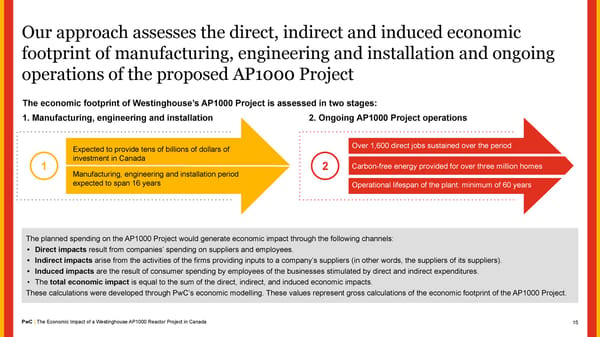Our approach assesses the direct, indirect and induced economic footprint of manufacturing, engineering and installation and ongoing operations of the proposed AP1000 Project The economic footprint of Westinghouse’s AP1000 Project is assessed in two stages: 1. Manufacturing, engineering and installation 2. Ongoing AP1000 Project operations Over 1,600 direct jobs sustained over the period Expected to provide tens of billions of dollars of investment in Canada Carbon-free energy provided for over three million homes 1 2 Manufacturing, engineering and installation period expected to span 16 years Operational lifespan of the plant: minimum of 60 years The planned spending on the AP1000 Project would generate economic impact through the following channels: • Direct impacts result from companies’ spending on suppliers and employees. • Indirect impacts arise from the activities of the firms providing inputs to a company’s suppliers (in other words, the suppliers of its suppliers). • Induced impacts are the result of consumer spending by employees of the businesses stimulated by direct and indirect expenditures. • The total economic impact is equal to the sum of the direct, indirect, and induced economic impacts. These calculations were developed through PwC’s economic modelling. These values represent gross calculations of the economic footprint of the AP1000 Project. PwC | The Economic Impact of a Westinghouse AP1000 Reactor Project in Canada 15
 The Economic Impact of a Westinghouse AP1000 Reactor Project in Canada Page 14 Page 16
The Economic Impact of a Westinghouse AP1000 Reactor Project in Canada Page 14 Page 16